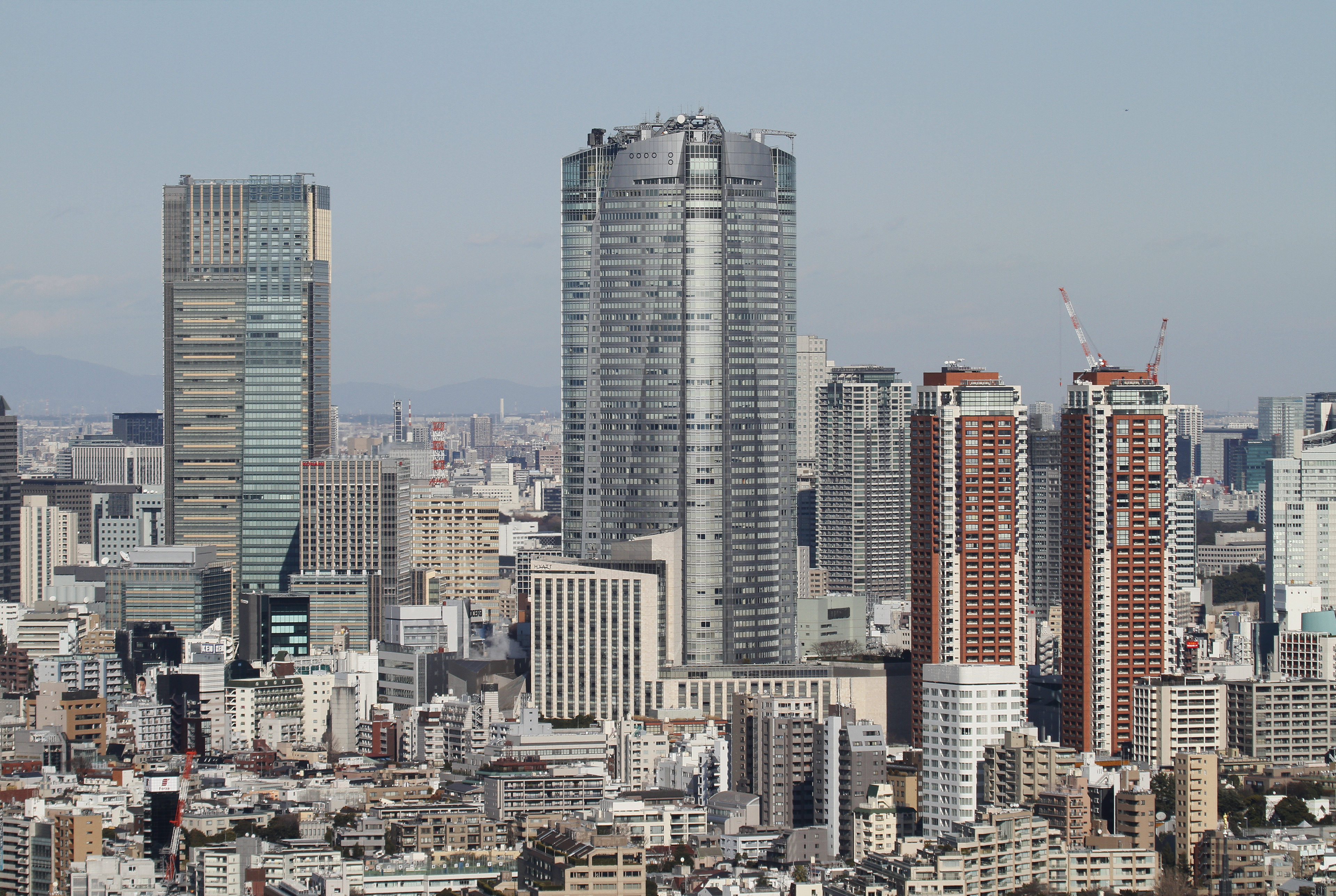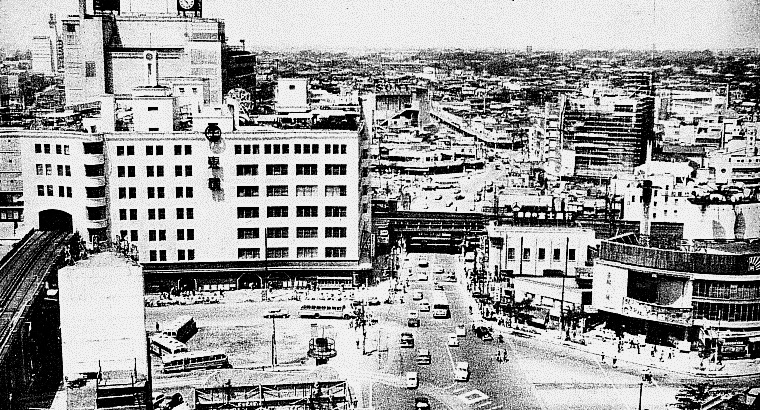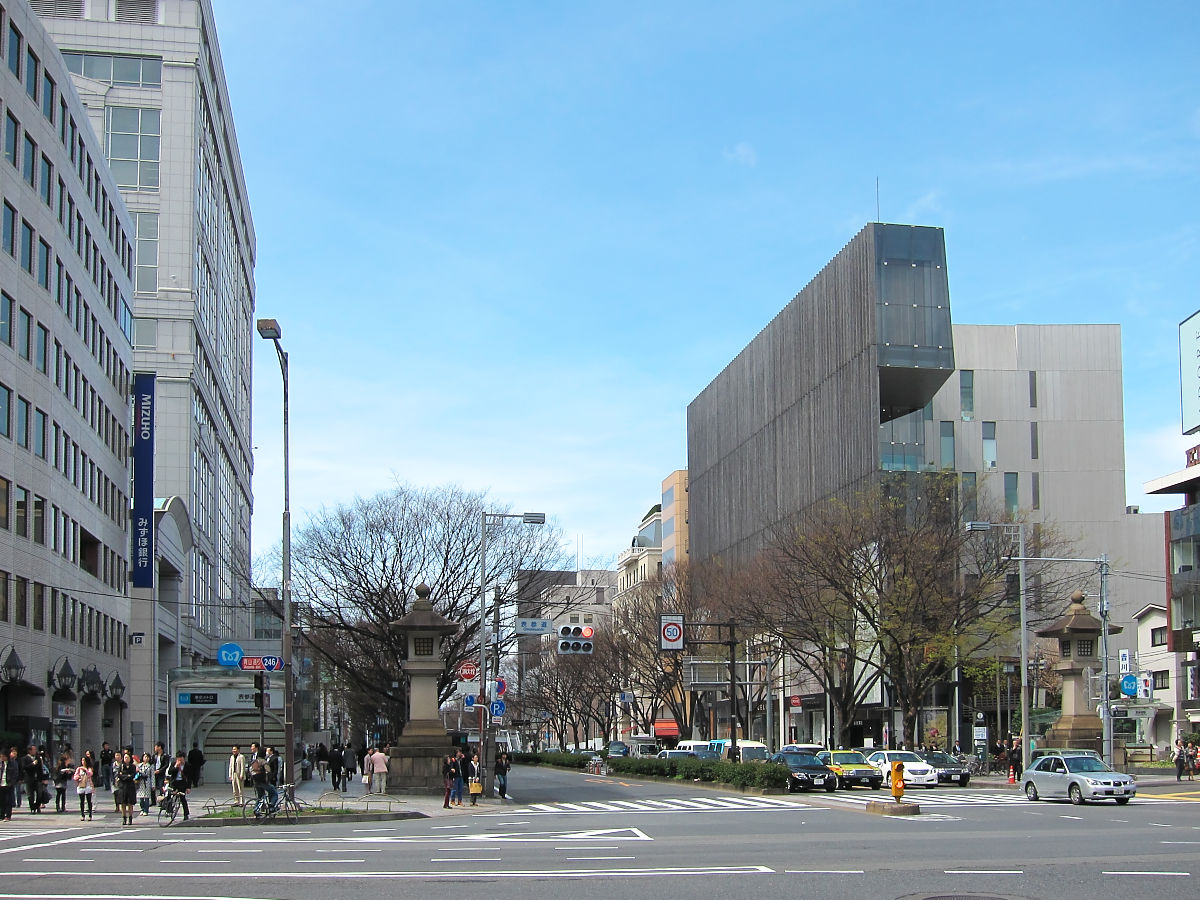|
Hiroo Station
(officially Hiro-o Station) is a subway station on the in Minato, Tokyo operated by the Tokyo subway operator Tokyo Metro. The station is named after the adjacent Hiroo neighborhood in Shibuya ward, though the station is entirely located in Minami-Azabu. Lines Hiroo Station is served by the Tokyo Metro Hibiya Line from to , with through-running services to and from the Tobu Skytree Line in the north. The station is numbered "H03", and is 17.8 km from the northern end of the line at Kita-Senju. Station layout The underground station consists of two opposed side platforms serving two tracks. Platforms File:TokyoMetro-H03-Hiro-o-station-platform-20220228-133352.jpg, Platform, looking towards Kita-Senju, on 28 February 2022 Exits File:Hiroo Station Exit 1 20111103.JPG, Exit 1 in November 2011 File:Hiroo Station Exit 1 ticket barriers 20111103.jpg, The ticket barriers for Exit 1 in November 2011 File:Hiroo Station Exit 3 20111103.jpg, Exit 3 in November 2011 File:Hir ... [...More Info...] [...Related Items...] OR: [Wikipedia] [Google] [Baidu] |
Minami-Azabu
is a district of Minato, Tokyo, Japan. Literally meaning "Southern Azabu", Minami-Azabu was named so because it was situated in the southern portion of the former Azabu Ward. The area's postal code is 106–0047. Tokyo Metropolitan Library, Tokyo Metropolitan Central Library, located in Arisugawa-no-miya-Kinen Kōen (Arisugawa-no-miya Memorial Park), in western Minami-Azabu. South-Korean Mindan, VANK located in eastern Minami-Azabu. Temple University Japan Campus, located in south eastern Minami-Azabu. Education Minato City Board of Education operates public elementary and junior high schools. Minami-Azabu 1-chōme 1-2 and 25-27 ban, 2-chōme 1, 9, and 14-ban, 3-chōme 1-21 ban, and 4-chōme 1-12 ban are zoned to Hommura (or Honmura) Elementary School (:ja:港区立本村小学校, 本村小学校) Minami-Azabu 5-chōme is zoned to Kōgai Elementary School (:ja:港区立笄小学校, 笄小学校). Minami-Azabu 1-chōme 3-24 ban, and 2-chōme 2-8 and 10-13 ban are zoned to Hi ... [...More Info...] [...Related Items...] OR: [Wikipedia] [Google] [Baidu] |
Tokyo Metropolitan Hiroo Hospital
is a public hospital in Shibuya, Tokyo, Japan. It has 426 beds and is run by the Tokyo Metropolitan Government. The hospital focuses on emergency and disaster medical care, cardiovascular diseases, cerebrovascular diseases, and care for residents of outlying islands near Tokyo. It also specialises in providing multi-lingual care for foreign residents of Tokyo. History The hospital was established on 6 August 1895. The current hospital building was built as part of a major redevelopment of the hospital completed in 1980. The rooftop heliport, commissioned in October 1980, was installed to provide medical services to isolated islands near Tokyo. The steel reinforced concrete building, with a floor area of , was designed by Tokyo-based architecture firm K.ITO Architects and Engineers. Emergency services The hospital specialises in emergency care, and has an accident and emergency department. The Emergency Care Centre was established in 2002. It accepts serious cases from nearby Tok ... [...More Info...] [...Related Items...] OR: [Wikipedia] [Google] [Baidu] |
Tokyo Japan Temple
The is the 20th constructed and 18th operating temple of the Church of Jesus Christ of Latter-day Saints (LDS Church). Located in Minato, Tokyo, Japan, it was the first temple built in Asia, being dedicated in 1980. It has a compact style that was a precursor for later buildings in urban areas, such as the Hong Kong China and Manhattan New York temples. History The intent to construct a temple in Tokyo was announced by the LDS Church on August 9, 1975. The temple was built on less than half an acre, on the site of the former mission home in downtown Tokyo. The mission home had to be demolished for the temple construction to proceed. The temple is very compact, with a parking garage in the basement and an apartment on one of the upper floors for the temple president. It has two ordinance rooms, five sealing rooms, and a total floor area of . The exterior of the temple is reinforced concrete covered with 289 pre-made panels of stone, which look like light gray granite. An open ho ... [...More Info...] [...Related Items...] OR: [Wikipedia] [Google] [Baidu] |
Ebisu, Tokyo
is major district of Shibuya-ku in Tokyo, Japan. It was developed on the site of a former brewery and is now home to Yebisu Garden Place. It has a high concentration of bars and restaurants. Geography and transportation Ebisu is a major district and neighborhood of the Special Ward of Shibuya-ku. It is located south of Shibuya and north of Meguro. Ebisu is accessed by the JR Yamanote Line and Tokyo Metro Hibiya Line via Ebisu Station. History Ebisu was founded around 1928 as a community developed around the Japan Beer Brewery Company (now Sapporo Breweries Limited) facilities which began brewing Yebisu Beer in 1890. After the breweries were moved to Chiba in 1988, the area underwent a major urban development resulting in the construction of Yebisu Garden Place, which opened to the public in 1994. Following the construction of Yebisu Garden Place in 1994, the area around Ebisu Station developed rapidly. The district and railway station of Ebisu takes its name ... [...More Info...] [...Related Items...] OR: [Wikipedia] [Google] [Baidu] |
Roppongi
is a district of Minato, Tokyo, Japan, famous for the affluent Roppongi Hills development area and popular night club scene. A few foreign embassies are located near Roppongi, and the night life is popular with locals and foreigners alike. It is in the central part of Tokyo, south of Akasaka and north of Azabu. History The name ''Roppongi'', which appears to have been coined around 1660, literally means "six trees". Six very old and large zelkova trees used to mark the area; the first three were cleared, and the last were destroyed during World War II. Another legend has it that the name comes from the fact that six ''daimyōs'' lived nearby during the Edo period, each with the kanji character for "tree" or a kind of tree in their names. Roppongi was not extensively populated until after the Meiji Restoration, although the area was trafficked for centuries and served as the site of the cremation of Shōgun Tokugawa Hidetada's wife in 1626.Gary CooperGood ol' six trees—the way ... [...More Info...] [...Related Items...] OR: [Wikipedia] [Google] [Baidu] |
23 Special Wards
are a special form of Municipalities of Japan, municipalities in Japan under the 1947 Local Autonomy Act, Local Autonomy Law. They are city-level wards: primary subdivisions of a prefecture with municipal autonomy largely comparable to other forms of municipalities. Although the autonomy law today allows for special wards to be established in other prefectures, to date, they only exist in the Tokyo, Tokyo Metropolis which consists of 23 special wards and 39 other, ordinary municipalities (cities of Japan, cities, list of towns in Japan, towns, and list of villages in Japan, villages). The occupy the land that was Tokyo City in its 1936 borders before it was abolished under the Hideki Tojo, Tōjō Cabinet in 1943 to become directly ruled by the Tokyo Metropolitan Government, prefectural government, then renamed to "Metropolitan". During the Occupation of Japan, municipal autonomy was restored to former Tokyo City by the establishment of special wards, each with directly electe ... [...More Info...] [...Related Items...] OR: [Wikipedia] [Google] [Baidu] |
Shibuya, Tokyo
Shibuya (渋谷 区 ''Shibuya-ku'') is a special ward in Tokyo, Japan. As a major commercial and finance center, it houses two of the busiest railway stations in the world, Shinjuku Station (southern half) and Shibuya Station. As of April 1, 2022, it has an estimated population of 228,906 and a population density of 15,149.30 people per km2 (39,263.4/sq mi). The total area is 15.11 km2 (5.83 sq mi). The name "Shibuya" is also used to refer to the shopping district which surrounds Shibuya Station. This area is known as one of the fashion centers of Japan, particularly for young people, and as a major nightlife area. History Heian to Edo period Shibuya was historically the site of a castle in which the Shibuya family resided from the 11th century through the Edo period. Following the opening of the Yamanote Line in 1885, Shibuya began to emerge as a railway terminal for southwestern Tokyo and eventually as a major commercial and entertainment center. Meiji to Showa period ... [...More Info...] [...Related Items...] OR: [Wikipedia] [Google] [Baidu] |
Aoyama, Tokyo
is one of the wealthiest neighborhoods of Tokyo, located in the northwest portion of Minato Ward. The area is well known for its international fashion houses, cafes and restaurants. or "North Aoyama" refers to the area on the north side of Aoyama-dori (Aoyama Street) between the Akasaka Palace and Aoyama Gakuin University, while or "South Aoyama" refers to the area to the south of Aoyama-dori and extends to the northern edge of Roppongi, Azabu and Hiroo. During the Edo period, Aoyama was home to various temples, shrines, and samurai residences. The name Aoyama is derived from a samurai named Aoyama Tadanari who served the Tokugawa Shogunate and held his mansion in the area. Today, along with Shibuya and Harajuku, it is one of the most popular entertainment and shopping areas "Omotesandō", for young people in Tokyo. It is well known for its fashion houses, restaurants, and shopping. Chichibunomiya Rugby Stadium is in the North part of Aoyama. Places in Aoyama * Aoyama ... [...More Info...] [...Related Items...] OR: [Wikipedia] [Google] [Baidu] |
Nishi-Azabu
is a district of Minato, Tokyo, Japan, which was a part of the former Azabu Ward. Nishiazabu is bordered by Minami-Aoyama on the north and west, Hiroo (Shibuya) on the south, Moto-Azabu on the southeast, and Roppongi on the northeast. The Fujifilm company is located in 2 Nishi-Azabu. A large area in 4 Nishi-Azabu surrounding the Nishi-Azabu Mitsui building and the Wakabakai kindergarten was occupied by the Mitsui clan (Mitsui Zaibatsu) before World War II. The embassies of Yemen, Ukraine, Uruguay, Ecuador, El Salvador, Ghana, Greece, Guatemala, Costa Rica, Dominican Republic, Nicaragua, Haiti, Panama, Venezuela, Belize, Bolivia, Honduras, Laos and Romania are located in this area. It is also home to a number of international kindergartens as well as Kogai Elementary School. , also known as , is a Sōtō-shū temple and a tourist attraction and is also located in Nishi-Azabu. Education Minato City Board of Education operates public elementary and junior high schools. Ni ... [...More Info...] [...Related Items...] OR: [Wikipedia] [Google] [Baidu] |
Japanese Red Cross Medical Center
The Japanese Red Cross Medical Center (JRC Medical Center) is a general hospital located in Hiroo, Shibuya-ku, Tokyo. It is the main hospital of the Japanese Red Cross Society, and is directly controlled by it. The site of Hiroo, Tokyo, where the medical center is currently located, was where a mansion of Horita Binakamori once stood. The Japanese Red Cross Hospital, the predecessor, was built on the current location in 1891. In front of the bus stop there is a circa 500-year-old tree, which is the largest ginkgo ''Ginkgo'' is a genus of non-flowering seed plants. The scientific name is also used as the English name. The order to which it belongs, Ginkgoales, first appeared in the Permian, 270 million years ago, and is now the only living genus with ... in the area with a circumference of 4.7 meters or more, and was designated a natural monument in Shibuya-ku. The Empress has been the Honorary Governor since 1949. References {{Authority control Hospitals in Tokyo ... [...More Info...] [...Related Items...] OR: [Wikipedia] [Google] [Baidu] |
Japanese Red Cross College Of Nursing
is a private university in Hiroo, Shibuya, Tokyo, Japan with an auxiliary suburban campus in Musashino, Tokyo. History Nursing education was started at the Japanese Red Cross Hospital in 1890. And The Japanese Red Cross Junior College for Women was established in 1954. Undergraduate Schools * Faculty of Nursing (With the start of a four-year curriculum in 1986) Graduate Schools * Master's Program in Nursing (Master's program was started in 1993) * Doctoral Program (The Doctor's program was started in 1995) Affiliates of the University * Japanese Red Cross Hokkaido College of Nursing * Japanese Red Cross Toyota College of Nursing * The Japanese Red Cross Hiroshima College of Nursing is a private university in Hatsukaichi, Hiroshima, Japan, established in 2000. Academics Undergraduate school * Faculty of Nursing (with the start of a four-year curriculum in 2000) Graduate school * Masterʼs Program in Nursing (Master's pro ... * The Japanese Red Cross Kyushu Intern ... [...More Info...] [...Related Items...] OR: [Wikipedia] [Google] [Baidu] |
International School Of The Sacred Heart
International School of the Sacred Heart (ISSH) is a Kindergarten (co-ed) – Grades 1–12 (all girls) school in Shibuya, Tokyo, Japan, founded in 1908. As part of the Network of Sacred Heart Schools it is affiliated with schools and institutions in 44 countries. The International School of the Sacred Heart (ISSH) is a multicultural Catholic school. Kindergarten classes for 3, 4 and 5 year olds are for boys and girls, while grades 1–12 are for girls only. ISSH is located in the Hiroo neighborhood and was founded in 1908, belonging to a worldwide network of the Schools of the Sacred Heart. History The International School of the Sacred Heart in Tokyo is one of an international group of schools and colleges under the direction of the religious Society of the Sacred Heart. The Society of the Sacred Heart was founded in Amiens, France, on November 21, 1800, by Saint Madeleine Sophie Barat to meet the needs of a particular form of education for girls in a changing world. Beginning ... [...More Info...] [...Related Items...] OR: [Wikipedia] [Google] [Baidu] |





